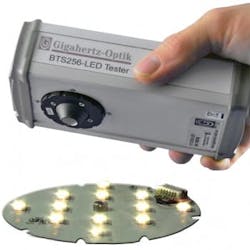Spectral radiant power test and measurement for light-emitting diodes (LEDs) offered by Gigahertz-Optik
AMESBURY, Mass. – Gigahertz-Optik Inc. in Amesbury, Mass., is introducing two versions of the company's BTS256-LED test and measurement system for photometric, colorimetric, and spectral radiometric testing in the visible spectral region.
These compact portable spectral radiant power measurement devices focus on single-ultraviolet or infrared light-emitting diodes (LEDs), and include a built-in integrating sphere with cone-shaped measurement port enabling hand-held or fixtured testing of circuit board-mounted LEDs for radiant power, SPD, and peak intensity.
These spectral radiant power measurement devices also offer on-board UV or IR auxiliary LEDs for absorption correction under software control typically found only on fixed bench-top LED measurement systems.
These testers enable the user to bring the measurement tool to the test LED for use in either in a hand-held or fixtured setup in incoming QC, R&D, production control or other test applications.
Related: Deep Red Surface-Mount LED - OD-685C
The BTS256-LED-UV calibrated spectral range is 200 to 550 nanometers with a bandwidth of 5 nanometers (optical bandwidth correction per CIE 214). It measures radiant power levels from 10 microwatts to 2 Watts (typ. 350 nanometers LED).
The BTS256-LED-IR calibrated spectral range is 750 to 1100 nanometers with a bandwidth of 5 nanometers (optical bandwidth correction per CIE 214). It measures radiant power levels from 0.3 microwatts to 5 Watts (typ. 900 nanometers LED).
The testers are operated and controlled using the supplied S-BTS256 application software which allows device settings like integration time, measurement settings, mathematical corrections, evaluations and all other functions.
Traceable calibration and certification of the BTS256-LED testers is performed in Gigahertz-Optik's ISO/IEC 17025 calibration laboratory that is accredited by DAkkS (D-K-15047-01-00) for the spectral responsivity and spectral irradiance according to ISO/IEC 17025.
Related: Military displays get smaller, lighter, tougher
The device receives two calibrations: one is done using a specially developed reference lamp offering 2pi illumination which enables precise measurement of the luminous flux of diffusely emitting LEDs. The second calibration is for sources that have narrower illumination characteristics.
Also, for other visible spectral photometric, colorimetric, radiometric LED measurement applications explore the BTS256-LED Plus Concept that shows how to extend usage of a BTS256-LED tester.
For more information contact Gigahertz-Optik online at www.gigahertz-optik.com.
